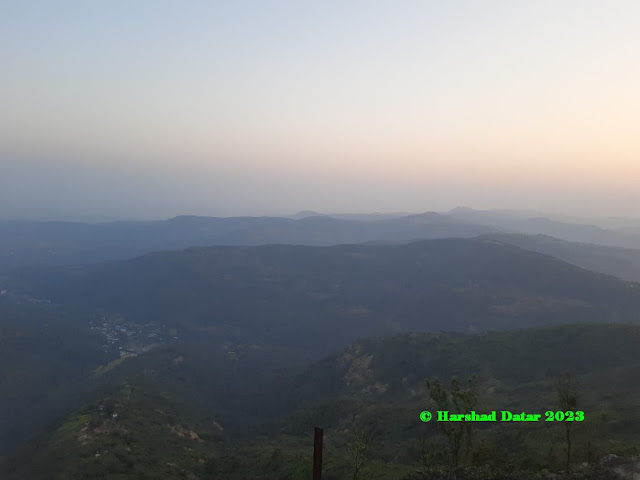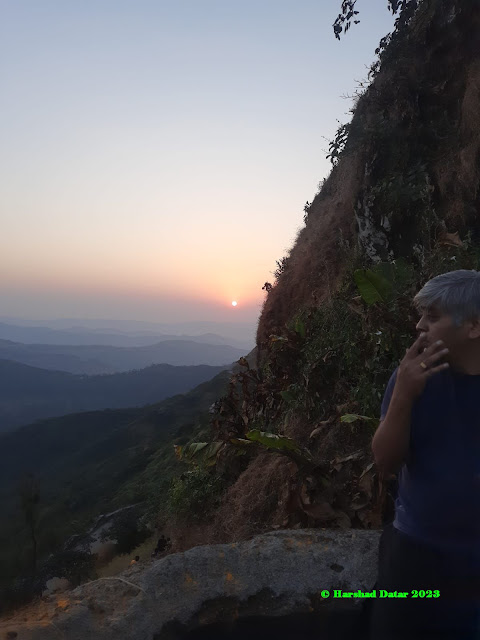 |
| Pune Darwaja, Trekkers Touch Point |
Introduction.
Sinhagad, an ancient fort tracing its history to almost 2000 years, was originally named Kondhana after Rishi Kondinya and was ruled by many dynasties before it became part of Maratha Swarajya under Chhatrapati Shivaji Maharaj. Chhatrapati Shivaji acquired this fort twice before peacefully but had to give it up this fort to the Mughals under the Treaty of Purandar in the year 1665. How it came back under the fold of Marathas is a folklore known to every old and young person in Maharashtra and beyond.
Who does not remember with due reverence, the heroic battle fought by the Maratha army in the year 1670 under Tanaji Malusare, of around 300 soldiers, in a daring midnight raid, with a mighty Mughal army of strength of roughly 5000 men under Subhedar Udaybhan Rathod, a brave Rajput working for Mughals. This happened on 4 Feb 1670. The famous words of Chhatrapati Shivaji, "Gad Aala pan Sinha Gela" (We won the fort but lost our Lion, Tanaji) still resound in people's ears.
Such a lofty fort, the second closest from Pune, the first being Malhargad, a small fortress across Dive Ghat (and the last one built by Marathas) and third being Purandar beyond Saswad, has been my dream trek. Dream trek, not because it is the toughest trek in the Syadhari mountains, it is actually graded easy, but because I wanted to tread on that very territory where Chatrapati's Mavals treaded, with nothing else but the willpower and love for motherland and freedom on a pitch dark night. For me, it was a long due Pilgrimage completed.
As for trekking, I am not a regular but I have done some treks that many have not down like Hemkund Saheb in Uttaranchal, and Tiger Nest Monastery at Bhutan, but Sinhagad, that is very special for every Marathi heart.
Location.
Situated about 40 km west of Pune on the Bhuleshwer range of Sahyadri Mountains, Sinhagad is 760 meters above ground and about 1300 meters from Mean Sea Level (MSL). It has a motorable road leading to public parking just a hundred meters away from one of its two gates, namely Pune Darwaja. One can travel to the fort by a two-wheeler, four-wheeler, or even by a cab or PMPL Bus.
Visiting the places of interest in this fort may take anywhere between 2 to 4 hours. There are places worth visiting including a Cannon storage, Stables, Tanaji Malusare memorial, Udaybhan Memorial, unfortunately generally disrespected by many visitors, Kali and Hanuman temple, Tilak Bungalow, Samadhi of Chatrapati Rajaram, who died here in 1700 CE. This fort also has a tank with clean drinking water called Dev Taki. There are various Burz of the fort that also can be visited.
Trekking to Sinhagad.
There are two ways to trek to the Sinhagad fort. the first one, which was used by us, is about 23 km from Swargate. One follows the Sinhagad road and after Khadakwasala dam, skirting DIAT, Girinagar, reaches Atkarwadi village. The trek starts from here and ends at Pune Darwaza. There is ample paid parking available for two and four-wheelers in this village. There are also a few hotels available for tea, snacks, breakfast, and lunch.
The second trek starts from Donje village and goes to Kalyan Darwaza. I have not experienced this trek.
There are also small hutments available on the trekking route serving Buttermilk, Lime Juice, bread and cute things like Raw mangoes, Amla, etc. Some of these huts also serve Pithale (a Dish made from Gram Flour) and Bhakari (Country flat bread made mostly of Shorgham flour), the diet staple, diet of this region.
This path is about 2.8 km with varying terrains to cover. some are plain, some are moderate climbs and some are steep climbs. Some people also mentioned (just overheard) that this trek has 4 or 5 stages but neither there are such markings nor such stages mentioned in any blog. Maybe they were referring to the kind of surfaces encountered by trekkers during this trek.
Sinhagad trek, from either route, is considered easy. both routes take about 2 hours for amateur trekkers. Seasoned trekkers, on the other hand, take about 45 to 50 minutes to reach the fort.
Many trekkers start early, very early, like at 4 a.m, particularly on weekends. It was mentioned that on weekends, it's a non-ending stream of trekkers going up the hill to Sinhagad. When we trekked on a Saturday, we did not experience such a rush but while we were descending, many trekkers were seen climbing up. late in the morning. All of them were troubled by the sharp and bright sun.
Trekking Essentials.
That brings me to list out the trekking essentials that I discerned with my experience -
1. Ample parking is available for trekkers for both 2 and 4-wheelers. That should not be a concern.
2. Dressing in comfortable sportswear and having some type of tracksuit top, in wintery months, and rain cover (in monsoon) is essential. Using Jeans and flashy tops will trouble the climbers as the heat builds up.
3. Use good sports shoes with a firm grip. If trekking shoes are used, that is even better.
4. A golf Cap would be helpful but is not essential.
5. Up to two ltr of drinking water is good enough for the ascent to Sinhagad. There are enough stalls available, which would be functional as one descends where water, lime juice, buttermilk, etc is available.
6. Most important of all is, to start early when the sun is not up. That is for two reasons, one, you will be able to reach on top with a relatively cooler climate before the Sun comes up. Second, witnessing the sunrise from Sinhagad is a great experience. One may need a torchlight to climb up early (we had climbed up in natural light but I would recommend carrying a torch by each individual climber).
7. A variety of Breakfast (and lunch) options are available along the way (which are useful during descent) and at the parking area. They are a boon for tired minds and legs when one is back from the trek.
Having covered most of the information. I wish all the trekkers to Sinhagad all the very best. Keep Walking.
Now some of the photos that I took at Sinhagad and on the way down (Remember, we climbed starting at 4 am when only natural light was there.
.jpg) |
| Pune in the night, from SInhagad hill |
.jpg) |
| Ugawala Chandra Punava Cha (Moon of Full Moon Night) |
 |
| Little Star Up in the Sky (Eakal Tara) |
.jpg) |
| Tya Chandrachya Chandanya (those stars accompanying the Moon) |
 |
| The village below (the start point) |
 |
| A very calm moon |
 |
| Breaking of Dawn |
 |
| Dawn as seen from Pune Darwaja |
 |
| Tejonidhi Lohgol (The bright Ironball) |
 |
| Final Climb |
.jpg) |
| Sayhadri Ranges |
 |
| Looking Down from Pune Darwaja Bastian |
 |
| Pune Darwaja |
Informative and interesting 👌
ReplyDelete